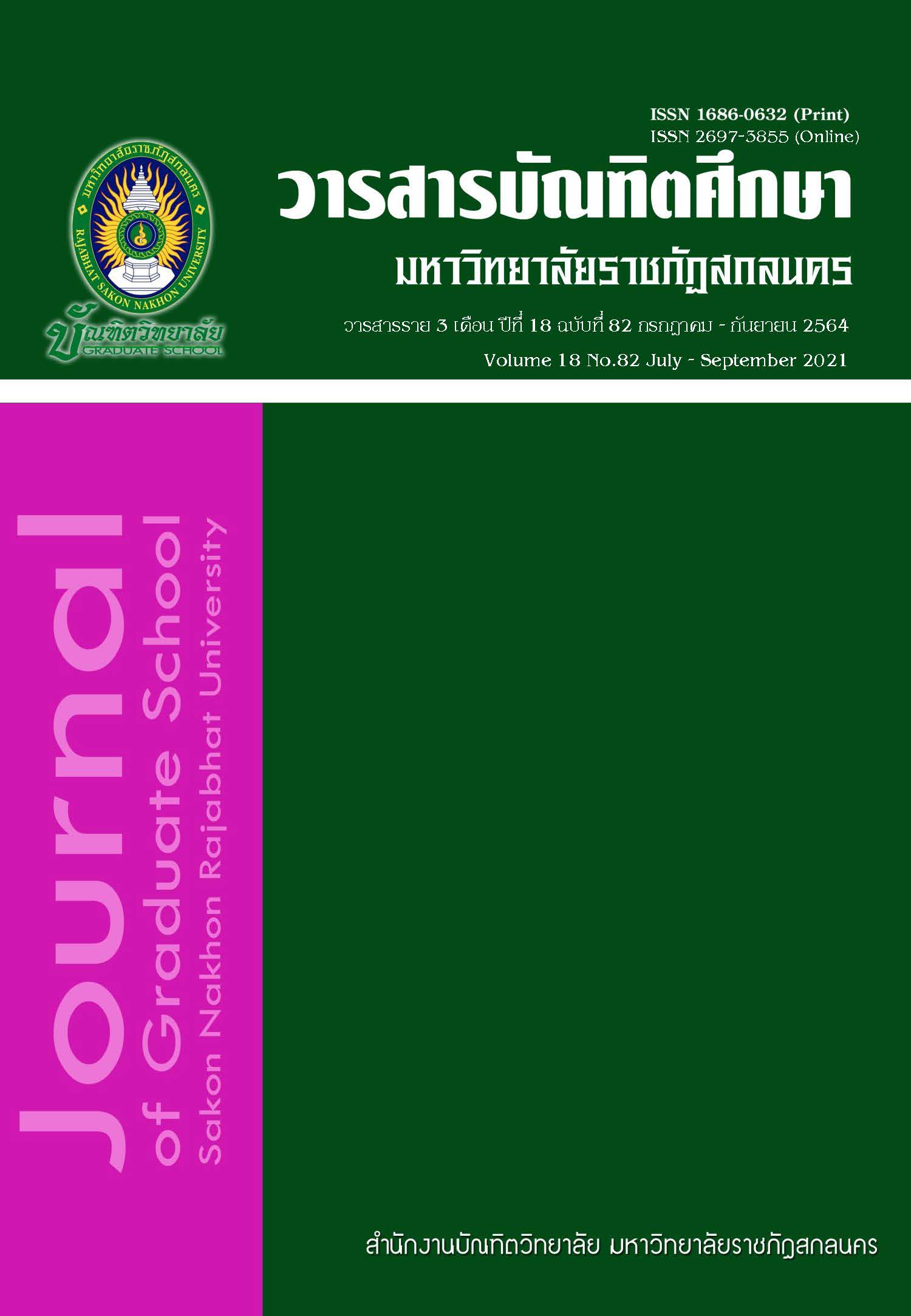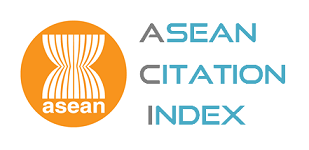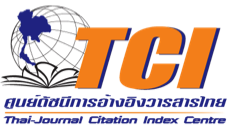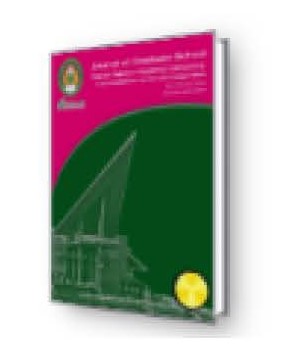ผลของการใช้รูปแบบการเรียนการสอนพิกเจอร์เวิร์ดที่มีต่อความสามารถใน การเรียนรู้คำศัพท์และการเขียนเชิงสร้างสรรค์ของนักเรียนชั้นประถมศึกษาปีที่ 3
Keywords:
Picture Word Inductive Model, Vocabulary Learning, Creative WritingAbstract
The purposes of this research were: 1) to compare vocabulary learning abilities of the experiment group students before and after learning through the picture word inductive model (PWIM); 2) to compare vocabulary learning abilities of the experimental group students learning through the PWIM and the control group students employing conventional instruction; 3) to compare the creative writing abilities of the experience group students before and after studied through the PWIM; 4) to compare the creative writing abilities of the experimental group students to those of students in the control group; and 5) to examine the satisfaction of the experimental group students toward the PWIM. The sample consisted of 70 Prathomsuksa 3 students who enrolled in the Ramkhamhaeng University Demonstration School (Elementary Level Division). The sample was divided into two groups: 35students in the experimental group and 35 students in the control group. The research instruments employed were: 1) four sets of lesson plans based on the PWIM, and four sets of lesson plans based on conventional instruction; 2) a vocabulary learning test; 3) a creative writing test; and 4) a questionnaire of students’ satisfaction toward the PWIM. Data were analyzed using mean, standard deviation, t-test for Dependent Samples and t-test for Independent Samples. The findings were as follows: 1. The vocabulary learning abilities of the experimental group students after the intervention were higher than those of before at the .05 level of significance. 2. The vocabulary learning abilities of the experimental group students were higher than those of the control group students at the .05 level of significance. 3. The creative writing abilities of the experimental group students after the intervention were higher than those of before at the .05 level of significance. 4. The creative writing abilities of the experimental group students were higher than those of the control group students at the .05 level of significance. 5. The satisfaction of the experimental group students toward the PWIM as a whole was at the highest level.
References
นวลทิพย์ เพิ่มเกษร. (2553). คำ: ปัจจัยสำคัญในการเขียน. วารสารวรรณวิทัศน์. 10, 94-106.
สถาบันทดสอบทางการศึกษาแห่งชาติ. (2562). การทดสอบทางการศึกษาระดับชาติขั้นพื้นฐาน ระดับชั้นประถมศึกษาปีที่ 6. เข้าถึงได้จาก https://www.niets.or.th/th/catalog/view/2989. 2 ธันวาคม 2563.
สำนักงานเลขาธิการสภาการศึกษา. (2562). มาตรฐานการศึกษาของชาติ พ.ศ. 2561. กรุงเทพฯ: 21 เซ็นจูรี่.
สำนักวิชาการและมาตรฐานการศึกษา. (2552). ตัวชี้วัด และสาระการเรียนรู้แกนกลางกลุ่มสาระการเรียนรู้ภาษาไทยตามหลักสูตรแกนกลางการศึกษาขั้นพื้นฐาน พุทธศักราช 2551. กรุงเทพฯ: ชุมนุมสหกรณ์การเกษตรแห่งประเทศไทย.
Appleman, D. (2013). Teaching in the dark: The promise and pedagogy of creative writing in prison. English Journal, 102(4), 24-30.
Bangun, N. S. (2015). The effect of using Picture Word Inductive Model (PWIM) on students’ achievement in writing narrative text. Undergraduate thesis, UNIMED: State University of Medan.
Boroushaki, N & Lee-Luan, Ng. (2016). Critical thinking ability and vocabulary learning strategy use: The case of EFL learners in an ESL context. Journal of Language and Translation, 6(1), 1-16.
Calhoun, E. F. (1999). Teaching beginning reading and writing with the picture word inductive model. Virginia: ASCD.
Consiglio, J. A. (2018). The effectiveness of the keyword method on foreign language vocabulary for students with learning disabilitiles. Ed. D. New Jersey: Rowan University.
Dobao, A. F. (2014). Vocabulary learning in collaborative tasks: A comparison of pair and small group work. Language Teaching Research, 18(4), 497–520.
Drewry, R. S. (2015). Selecting vocabulary for interactive read-alouds: six intermediate literacy collaborative teachers’ choices. Ph.D. Ohio: The Ohio State University.
Graham, S. et al. (2012). Teaching elementary school students to be effective writers: A practice guide (NCEE 2012-4058). Washington, DC: National Center for Education Evaluation and Regional Assistance, Institute of Education Sciences, U.S. Department of Education.
Hamzah, A. (2018). Picture Word Inductive Model (PWIM) in vocabulary learning. EEAL Journal (English Education and Applied Linguistics), 1(2), 138-141.
Hemphill, L & Tivnan, T. (2008). The importance of early vocabulary for literacy achievement in High-Poverty Schools. Journal of Education for Students Placed at Risk, 13, 426–451.
Hidayard, F. (2017). Teaching writing descriptive text by using Picture Word Inductive Model (PWIM) to the eighth grade students of SMP Negeri 2 Lawang Wetan in Musi Banyuasin. ELTE Journal, 5(1), 87-98.
Joyce, B; Weil, M & Calhoun, E. (2015). Model of Teaching. New Jersey: Person.
Maskor, Z. M & Baharudin, H. (2016). Receptive vocabulary knowledge or productive vocabulary knowledge in writing skill, which one important?. International Journal of Academic Research in Business and Social Sciences, 6(11), 261-271.
Nurani, S & Rosyada, A. (2017). Implemented PWIM in developing students’ communicative competence of SMK Islam Wijaya Kusuma Jakarta. Lingua Cultura, 11(1), 25-30.
Pushpanathan, T. (2017). The impact of using picture in the classroom for vocabulary enrichment: A meta-analysis” AGU International. Journal of Research in Social Sciences & Humanities, 5, 164-168.
Sari, F. (2018). A comparative study between Picture Word Inductive Model (PWIM) and Memorization Learning Model to teach vocabulary at seventh grade MTsN 3 Boyolali in the academic year 2018/2019. B.Ed, Jawa Tengah: the state Islamic institute of Surakarta.
Trilling, B & Fadel, C. (2009). 21st century skill: Learning for life in our times. San Francisco. Jossey-Bass.
Downloads
Published
How to Cite
Issue
Section
License
บทความทุกบทความที่ตีพิมพ์ในวารสารบัณฑิตศึกษา มหาวิทยาลัยราชภัฏสกลนคร ถือว่าเป็นลิขสิทธิ์ของบัณฑิตวิทยาลัย มหาวิทยาลัยราชภัฏสกลนคร










